Denis Gudovskiy
SeRpEnt: Selective Resampling for Expressive State Space Models
Jan 20, 2025



Abstract:State Space Models (SSMs) have recently enjoyed a rise to prominence in the field of deep learning for sequence modeling, especially as an alternative to Transformers. Their success stems from avoiding two well-known drawbacks of attention-based models: quadratic complexity with respect to the sequence length and inability to model long-range dependencies. The SSM variant Mamba has demonstrated performance comparable to Transformers without any form of attention, thanks to the use of a selective mechanism for the state parameters. Selectivity, however, is only evaluated empirically and the reasons of its effectiveness remain unclear. In this work, we show how selectivity is related to the sequence processing. Our analysis shows that selective time intervals in Mamba act as linear approximators of information. Then, we propose our SeRpEnt architecture, a SSM that further exploits selectivity to compress sequences in an information-aware fashion. It employs a resampling mechanism that aggregates elements based on their information content. Our empirical results in the Long Range Arena benchmark and other language modeling tasks show benefits of the SeRpEnt's resampling mechanism.
DFM: Interpolant-free Dual Flow Matching
Oct 11, 2024


Abstract:Continuous normalizing flows (CNFs) can model data distributions with expressive infinite-length architectures. But this modeling involves computationally expensive process of solving an ordinary differential equation (ODE) during maximum likelihood training. Recently proposed flow matching (FM) framework allows to substantially simplify the training phase using a regression objective with the interpolated forward vector field. In this paper, we propose an interpolant-free dual flow matching (DFM) approach without explicit assumptions about the modeled vector field. DFM optimizes the forward and, additionally, a reverse vector field model using a novel objective that facilitates bijectivity of the forward and reverse transformations. Our experiments with the SMAP unsupervised anomaly detection show advantages of DFM when compared to the CNF trained with either maximum likelihood or FM objectives with the state-of-the-art performance metrics.
SparseVLM: Visual Token Sparsification for Efficient Vision-Language Model Inference
Oct 06, 2024



Abstract:In vision-language models (VLMs), visual tokens usually consume a significant amount of computational overhead, despite their sparser information density compared to text tokens. To address this, most existing methods learn a network to prune redundant visual tokens and require additional training data. Differently, we propose an efficient training-free token optimization mechanism dubbed SparseVLM without extra parameters or fine-tuning costs. Concretely, given that visual tokens complement text tokens in VLMs for linguistic reasoning, we select visual-relevant text tokens to rate the significance of vision tokens within the self-attention matrix extracted from the VLMs. Then we progressively prune irrelevant tokens. To maximize sparsity while retaining essential information, we introduce a rank-based strategy to adaptively determine the sparsification ratio for each layer, alongside a token recycling method that compresses pruned tokens into more compact representations. Experimental results show that our SparseVLM improves the efficiency of various VLMs across a range of image and video understanding tasks. In particular, LLaVA equipped with SparseVLM reduces 61% to 67% FLOPs with a compression ratio of 78% while maintaining 93% of the accuracy. Our code is available at https://github.com/Gumpest/SparseVLMs.
ContextFlow++: Generalist-Specialist Flow-based Generative Models with Mixed-Variable Context Encoding
Jun 02, 2024



Abstract:Normalizing flow-based generative models have been widely used in applications where the exact density estimation is of major importance. Recent research proposes numerous methods to improve their expressivity. However, conditioning on a context is largely overlooked area in the bijective flow research. Conventional conditioning with the vector concatenation is limited to only a few flow types. More importantly, this approach cannot support a practical setup where a set of context-conditioned (specialist) models are trained with the fixed pretrained general-knowledge (generalist) model. We propose ContextFlow++ approach to overcome these limitations using an additive conditioning with explicit generalist-specialist knowledge decoupling. Furthermore, we support discrete contexts by the proposed mixed-variable architecture with context encoders. Particularly, our context encoder for discrete variables is a surjective flow from which the context-conditioned continuous variables are sampled. Our experiments on rotated MNIST-R, corrupted CIFAR-10C, real-world ATM predictive maintenance and SMAP unsupervised anomaly detection benchmarks show that the proposed ContextFlow++ offers faster stable training and achieves higher performance metrics. Our code is publicly available at https://github.com/gudovskiy/contextflow.
VeCAF: VLM-empowered Collaborative Active Finetuning with Training Objective Awareness
Jan 15, 2024Abstract:Finetuning a pretrained vision model (PVM) is a common technique for learning downstream vision tasks. The conventional finetuning process with the randomly sampled data points results in diminished training efficiency. To address this drawback, we propose a novel approach, VLM-empowered Collaborative Active Finetuning (VeCAF). VeCAF optimizes a parametric data selection model by incorporating the training objective of the model being tuned. Effectively, this guides the PVM towards the performance goal with improved data and computational efficiency. As vision-language models (VLMs) have achieved significant advancements by establishing a robust connection between image and language domains, we exploit the inherent semantic richness of the text embedding space and utilize text embedding of pretrained VLM models to augment PVM image features for better data selection and finetuning. Furthermore, the flexibility of text-domain augmentation gives VeCAF a unique ability to handle out-of-distribution scenarios without external augmented data. Extensive experiments show the leading performance and high efficiency of VeCAF that is superior to baselines in both in-distribution and out-of-distribution image classification tasks. On ImageNet, VeCAF needs up to 3.3x less training batches to reach the target performance compared to full finetuning and achieves 2.8% accuracy improvement over SOTA methods with the same number of batches.
Efficient Deweather Mixture-of-Experts with Uncertainty-aware Feature-wise Linear Modulation
Dec 27, 2023
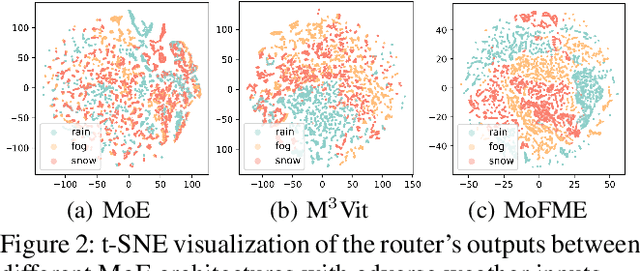
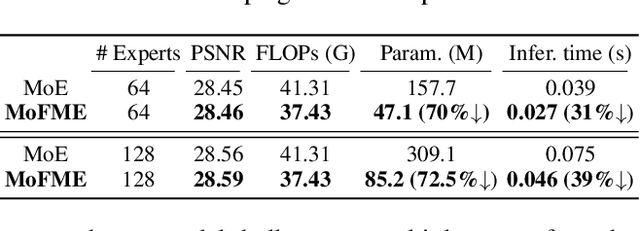
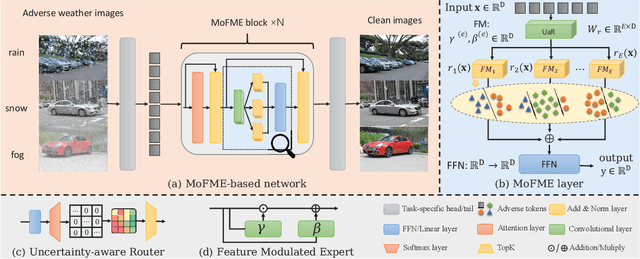
Abstract:The Mixture-of-Experts (MoE) approach has demonstrated outstanding scalability in multi-task learning including low-level upstream tasks such as concurrent removal of multiple adverse weather effects. However, the conventional MoE architecture with parallel Feed Forward Network (FFN) experts leads to significant parameter and computational overheads that hinder its efficient deployment. In addition, the naive MoE linear router is suboptimal in assigning task-specific features to multiple experts which limits its further scalability. In this work, we propose an efficient MoE architecture with weight sharing across the experts. Inspired by the idea of linear feature modulation (FM), our architecture implicitly instantiates multiple experts via learnable activation modulations on a single shared expert block. The proposed Feature Modulated Expert (FME) serves as a building block for the novel Mixture-of-Feature-Modulation-Experts (MoFME) architecture, which can scale up the number of experts with low overhead. We further propose an Uncertainty-aware Router (UaR) to assign task-specific features to different FM modules with well-calibrated weights. This enables MoFME to effectively learn diverse expert functions for multiple tasks. The conducted experiments on the multi-deweather task show that our MoFME outperforms the baselines in the image restoration quality by 0.1-0.2 dB and achieves SOTA-compatible performance while saving more than 72% of parameters and 39% inference time over the conventional MoE counterpart. Experiments on the downstream segmentation and classification tasks further demonstrate the generalizability of MoFME to real open-world applications.
Concurrent Misclassification and Out-of-Distribution Detection for Semantic Segmentation via Energy-Based Normalizing Flow
May 16, 2023Abstract:Recent semantic segmentation models accurately classify test-time examples that are similar to a training dataset distribution. However, their discriminative closed-set approach is not robust in practical data setups with distributional shifts and out-of-distribution (OOD) classes. As a result, the predicted probabilities can be very imprecise when used as confidence scores at test time. To address this, we propose a generative model for concurrent in-distribution misclassification (IDM) and OOD detection that relies on a normalizing flow framework. The proposed flow-based detector with an energy-based inputs (FlowEneDet) can extend previously deployed segmentation models without their time-consuming retraining. Our FlowEneDet results in a low-complexity architecture with marginal increase in the memory footprint. FlowEneDet achieves promising results on Cityscapes, Cityscapes-C, FishyScapes and SegmentMeIfYouCan benchmarks in IDM/OOD detection when applied to pretrained DeepLabV3+ and SegFormer semantic segmentation models.
Cross-Domain Object Detection with Mean-Teacher Transformer
May 03, 2022
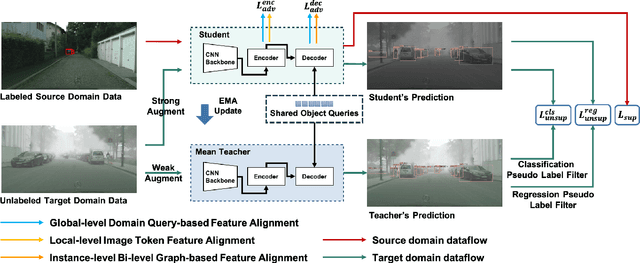


Abstract:Recently, DEtection TRansformer (DETR), an end-to-end object detection pipeline, has achieved promising performance. However, it requires large-scale labeled data and suffers from domain shift, especially when no labeled data is available in the target domain. To solve this problem, we propose an end-to-end cross-domain detection transformer based on the mean teacher knowledge transfer (MTKT), which transfers knowledge between domains via pseudo labels. To improve the quality of pseudo labels in the target domain, which is a crucial factor for better domain adaptation, we design three levels of source-target feature alignment strategies based on the architecture of the Transformer, including domain query-based feature alignment (DQFA), bi-level-graph-based prototype alignment (BGPA), and token-wise image feature alignment (TIFA). These three levels of feature alignment match the global, local, and instance features between source and target, respectively. With these strategies, more accurate pseudo labels can be obtained, and knowledge can be better transferred from source to target, thus improving the cross-domain capability of the detection transformer. Extensive experiments demonstrate that our proposed method achieves state-of-the-art performance on three domain adaptation scenarios, especially the result of Sim10k to Cityscapes scenario is remarkably improved from 52.6 mAP to 57.9 mAP. Code will be released.
Contrastive Neural Processes for Self-Supervised Learning
Oct 31, 2021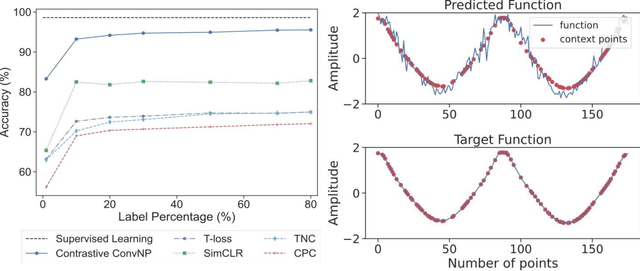

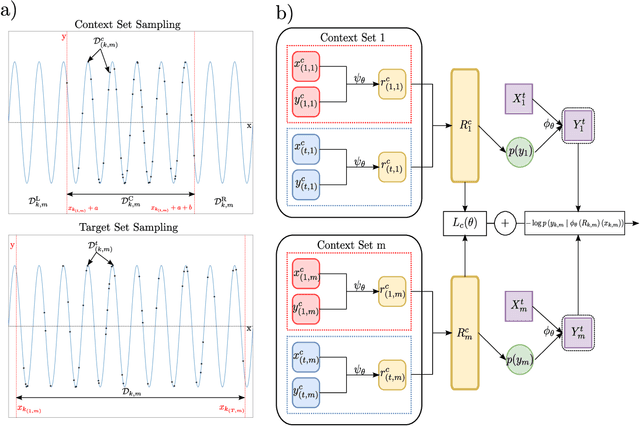

Abstract:Recent contrastive methods show significant improvement in self-supervised learning in several domains. In particular, contrastive methods are most effective where data augmentation can be easily constructed e.g. in computer vision. However, they are less successful in domains without established data transformations such as time series data. In this paper, we propose a novel self-supervised learning framework that combines contrastive learning with neural processes. It relies on recent advances in neural processes to perform time series forecasting. This allows to generate augmented versions of data by employing a set of various sampling functions and, hence, avoid manually designed augmentations. We extend conventional neural processes and propose a new contrastive loss to learn times series representations in a self-supervised setup. Therefore, unlike previous self-supervised methods, our augmentation pipeline is task-agnostic, enabling our method to perform well across various applications. In particular, a ResNet with a linear classifier trained using our approach is able to outperform state-of-the-art techniques across industrial, medical and audio datasets improving accuracy over 10% in ECG periodic data. We further demonstrate that our self-supervised representations are more efficient in the latent space, improving multiple clustering indexes and that fine-tuning our method on 10% of labels achieves results competitive to fully-supervised learning.
CFLOW-AD: Real-Time Unsupervised Anomaly Detection with Localization via Conditional Normalizing Flows
Jul 27, 2021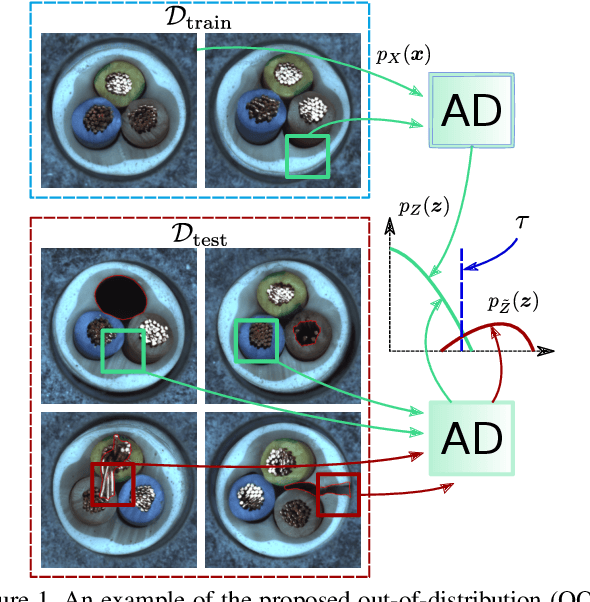


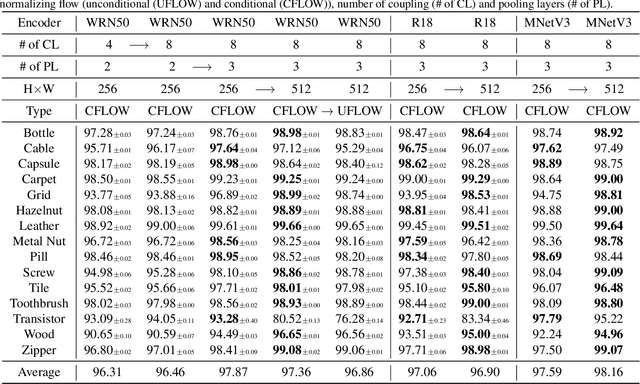
Abstract:Unsupervised anomaly detection with localization has many practical applications when labeling is infeasible and, moreover, when anomaly examples are completely missing in the train data. While recently proposed models for such data setup achieve high accuracy metrics, their complexity is a limiting factor for real-time processing. In this paper, we propose a real-time model and analytically derive its relationship to prior methods. Our CFLOW-AD model is based on a conditional normalizing flow framework adopted for anomaly detection with localization. In particular, CFLOW-AD consists of a discriminatively pretrained encoder followed by a multi-scale generative decoders where the latter explicitly estimate likelihood of the encoded features. Our approach results in a computationally and memory-efficient model: CFLOW-AD is faster and smaller by a factor of 10x than prior state-of-the-art with the same input setting. Our experiments on the MVTec dataset show that CFLOW-AD outperforms previous methods by 0.36% AUROC in detection task, by 1.12% AUROC and 2.5% AUPRO in localization task, respectively. We open-source our code with fully reproducible experiments.
 Add to Chrome
Add to Chrome Add to Firefox
Add to Firefox Add to Edge
Add to Edge